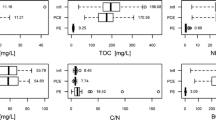Abstract
Two thousand plants of the water hyacinth,Eichornia crassipes Solms., were introduced on April 11, 1971, into a series of five ponds, each 5000 sq. ft. in area and 2.6 ft. deep. Treated waste water effluent from the Ames sewage treatment plant filled the ponds and was added to pond 1 at 127 gallons per minute. By growth and vegetative reproduction, these plants increased to more than 500,000, and all five ponds were covered completely by July 26. On that date, the extrapolated estimate of total wet weight was 287 U.S. tons/ acre (645 metric tons/hectare; 64500g/m2). The estimate of oven dry weight was 13.2 U.S. tons/acre (29.7 metric tons/hectare; 2970g/m2). Ammonia and nitrate disappeared rapidly from the pond water, and phosphate concentrations were lowered appreciably. Evapotranspiration and seepage accounted for water losses of more than 0.5 inches per day. The potential economic values of this plant and its possible use in tertiary treatment to reduce N and P components in waste waters are discussed briefly.
Similar content being viewed by others
Literature cited
Arnott, H. J. 1966. Studies of calcification in plants.In H. Fleisch, H. J. Blackwood, and M. Owen, (ed.), European symposium on calcified tissues. Springer Verlga, Berlin.
Boyd, C. E. 1968. Evaluation of some common aquatic weeds as possible feedstuffs. Hyacinth Control Journal7: 26–27.
—.1969. The nutritive value of three species of water weeds. Economic Botany23: 123–127.
—. 1970. Vascular aquatic plants for mineral nutrient removal from polluted waters. Economic Botany24: 95–103.
—, and D. H. Vickers. 1971. Variation in the elemental content ofEichornia crassipes. Hydrobiologia38: 409–414.
Chadwick, M. J., and M. Obeid. 1966. A comparative study of the growth ofEichornia crassipes Solms. andPistia stratiotes L. in water culture. Journal of Ecology54: 563–575.
Dymond, G. C. 1948. The water hyacinth: A Cinderella of the plant world. In J. P. J. Van Vuren, (ed.), Soil fertility and sewage. Dover Publications, New York. 236 p.
Hach. 1969. Water and waste water analysis: Procedures. Hach Chemical Co., Ames, Iowa. 105 p.
Huggins, Thomas G. 1969. Production of channel catfish(Ictalurus punctatus) in tertiary treatment ponds. Unpublished M. S. thesis, Iowa State Univ., Ames.
Levitt, Jacob. 1969. Introduction to plant physiology. C. V. Mosby Co., St. Louis, 304 p.
Little, E. C. S. (ed.). 1968. Handbook on utilization of aquatic plants. Food and Agricultural Organization of the United Nations, Rome, Italy. 121 p.
Miner, J., J. W. Wooten, and J. D. Dodd. 1971. Water hyacinths to further treat anaerobic lagoon effluent. Proceedings of International Symposium on Livestock Wastes: 170–172.
Parija,P. 1934. Physiological investigations on water hyacinth(Eichornia crassipes) in Orissa with notes on some other aquatic weeds. Indian Journal of Agricultural Science4: 399–429.
Penfound, W. T. 1956. Primary production of vascular aquatic plants. Limnology and Oceanography1: 92–101.
—, and T. T. Earle. 1948. The biology of the water hyacinth. Ecological Monographs18: 449–472.
Pirie, N. W. 1964. Novel protein sources for use as human food in wet tropical regions. 1st Congress International des Industries Alimentaires at Agricoles. 237–248.
Raschke, R. L. 1968. Algal periodicity, primary production, and waste reclamation in a tertiary sewage stabilization pond ecosystem. Unpublished Ph. D. thesis, Iowa State Univ. Ames.
—. 1970. Algal periodicity and waste reclamation in a stabilization pond ecosystem. JWPCF42(4): 518–530.
Rogers H. H., and D. E. Davis. 1972. Nutrient removal by water hyacinth. Weed Science20: 423–428.
Vaas, K. F. 1951. Notes on the water hyacinth in Indonesia and its eradication by spraying with 2, 4-D. Contributions of the General Agricultural Research Station, Bogor, Indonesia120: 1–59.
Vetter,R. 1972. Preliminary tests on the feeding value for cattle of fresh and processed water hyacinths. Iowa Agriculture and Home Economics Experiment Station Animal Science Leaflet R169: 1–3.
Yount, James L., and R. A. Crossman, Jr. 1970. Eutrophication control by plant harvesting. JWPCF42: 173–183.
Westlake, D. F. 1963. Comparisons of plant productivity. Biological Review38: 385–425.
Author information
Authors and Affiliations
Additional information
Journal Paper No. J-7744 of the Iowa Agriculture and Home Economics Experiment Station, Ames, Iowa. Project No. 1842. The ponds utilized in the study are part of the sewage treatment facilities of the City of Ames, Iowa, and were made available through the courtesy of Dr. Harris Seidel, Director of the Ames Water Pollution Control Plant.
Rights and permissions
About this article
Cite this article
Wooten, J.W., Dodd, J.D. Growth of water hyacinths in treated sewage effluent. Econ Bot 30, 29–37 (1976). https://doi.org/10.1007/BF02866781
Received:
Issue Date:
DOI: https://doi.org/10.1007/BF02866781




